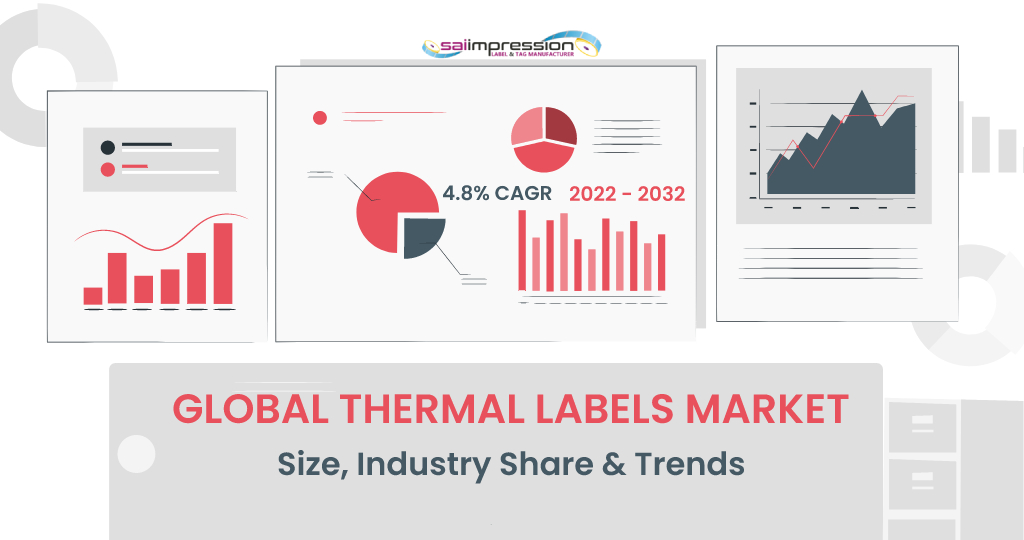Global Thermal Labels Market Size, Industry Share & Trends – An Insightful Report

Global Thermal Label market trend is going to be upward for at least the entire decade with a 4.8% CAGR. Read our insightful report for more.
Thermal labels are significantly a massive part of the labels industry. From printing parking tickets to high-volume shipment tracking labels, they’re ubiquitous. Thermal Labels are a go-to option for labeling solutions for the industries having the largest share in the label market, i.e., food and beverages! That makes it crucial to know thermal label trends and thermal market size.
It’s not surprising that the Thermal Label market is exhibiting an upward trend and is forecasted to grow at a 4.8% CAGR from the year 2022 to the year 2032. However, COVID took a toll on the positive stats for a while, but it is booming again.
Contents
Thermal Labels, Types, and Applications
Before we go through the statistics of the thermal label industry, let’s know about the type and their applications. Based on the printing method, we can classify thermal labels into two types: thermal transfer labels and direct thermal labels.
Thermal transfer labels use heated ribbons to create an image on the label material. Thermal transfer labels are more durable with superior clarity in text or graphics to be printed. Thus, thermal transfer printing is widely used for logistic labels, food and beverage product Labels, warehouse labels, retail labels, laboratory specimens, and labeling requirements for other extreme environmental conditions.
Thermal Labels
If used on chromo labels or chromo blank labels, you can utilize the full potential of thermal transfer printing. Whether tint labels, colored plain labels, or self-adhesive carton labels, thermal transfer printing economically offers high-quality output.
Chromo Labels
Those printing ribbons are made up of wax, resin, or other plastic types. That means thermal labels are pretty versatile with their applications. Moreover, ribbons produce crisp, high-definition prints.
On the flip side, direct thermal label printing uses only paper as the consumable as no ink is involved. The plain label material is paper that’s chemically prepared and heat sensitive. The image surfaces on the label when the paper passes through the thermal printer head.
Since the label material is heat sensitive, it is not much of use where operating temperatures are high. Also, direct thermal labels do not stand against rubbing, abrasion, and scratches. Despite such downsides, direct thermal labels are suitable and apt for many applications.
For instance, printing credit card receipts at POS, parking tickets, shipping labels, visitor identification, barcode labels, carton labels, and box labels. Labels in such domains do not require superior features like durability, high resolution, and temperature resistance. And not to mention its cost-effectiveness.
All in all, both thermal labels complement each other, considering their pros and cons.
Categorization of Thermal Label Market
To understand the thermal label market, you can study them category-wise to get the best insights. Here’s how we’ve categorized the thermal label market in this report.
Based on the material used
- Paper
- Plastic
Based on the printing tech used
- Direct thermal labels
- Thermal transfer labels
Based on Application
- Semiconductor and electronics
- Healthcare
- Food and beverages
- Others (Industrial)
Based on Region
- North America
- Latin America
- Europe
- Middle east and Africa
- East Asia
- South Asia
- Oceania
Overlook on Thermal Label Global Market: Historical and Forecasting
The thermal label market is enormous and is expected to be 892.4 million USD by the end of the current year, 2022. The market has been estimated to grow at a 4.8% CAGR from 2022 to 2032. That’ll make the industry of a whopping 1,420.5 million USD.
Last year in 2021, the thermal label global market was 851.5 million USD. This number is promising, especially since achieving normalcy after the COVID-19 outbreak. Experts have forecasted that the top 3 countries will sustain as torchbearers with more than 50% of the global thermal label market, including India.
Regional Insights on Thermal Label Market
1.The key player in the thermal labels market will be India, with about 30% of the share for the next decade. Indian thermal label market is expected to achieve at least 51.7 million USD of increment for the decade 2022-2032 with a 5.4% CAGR.
2. Indian landscape is rich with raw materials required for thermal printing and skilled as well as economic labor. Additionally, the meteoric rise in the demand for food, beauty, fashion products, and products from other industries will be the driving factor for the growth of the thermal label market.
3. The United States will hold about 19% of the global thermal label market share with a growth rate of 3.7% CAGR for the upcoming decade. The calculation shows Americal thermal label market size would be 267.0 million USD by the end of 2032.
4. Currently, the USA holds the highest share in the global thermal label market and there will be a largest labels manufacturers who manufacture & deliver quality labels according to the business need. Well, that’s not surprising considering the dynamic nature of the lifestyle, cultural requirements, need for convenience, and the rising demand for essentials.
5. With the growing food and beverages industry, companies have to face tough competition, which makes them rely on cost-effective thermal label printing in the United States.
The direct thermal label secures 63% of the global thermal label market. This is due to the increasing demand for convenience and short-term labeling requirements. Experts at FMI have forecasted that this share would be 1.5 times in the year 2032 than it’s now.
In the past year, 2021, the plastic segment of the thermal label industry was about 61% which will be approximately 63% in 2032, with about 350 million USD increment in the global thermal label market share.





